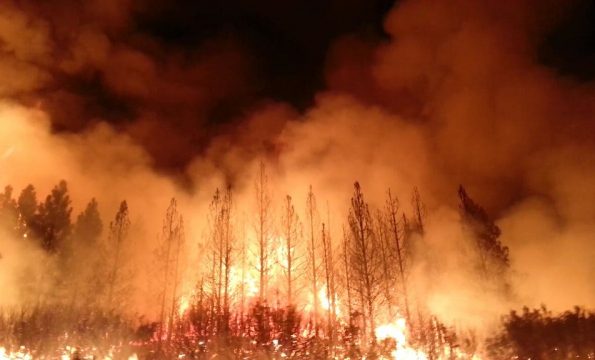“The largest fire in California history continued to grow… while firefighters worked to protect threatened communities. Crews are on especially high alert this week after a firefighter who traveled from Draper City, Utah, to help battle the blaze died… while working on an active stretch.
“We always talk about having our head on a swivel when we’re out on the fire line, because things could change — it could happen right there, in a snap of your fingers,” said Trevor Pappas, a firefighter with the California Department of Forestry and Fire Protection. “You have to have plan A, B, C, D — and sometimes E, F, G.” Every five or 10 minutes, firefighters on the line are encouraged to “look up, look around and make a sound,” Pappas said.
“Conditions have been ripe for the erratic fire behavior that has led to the explosive growth of the Ranch fire, which along with the River fire makes up the 364,145-acre Mendocino Complex fire. The days are so hot and dry that whatever gains firefighters see overnight when the humidity goes up quickly fade when the sun hits the fuels and sucks the moisture out.
“Lately, winds have started to pick up about 5 p.m., gusting to between 15 and 25 mph. ‘That will really push a fire — no person on Earth runs 25 mph,’ Pappas said. ‘We all want to go home at the end of the day, or the end of the shift, and make it back to our families.’
“That presents another challenge for firefighters. Unlike the Clear Lake area, which is fairly accessible by road, these communities are farther into the forest and surrounded by more rugged terrain, said Cary Wright, a Cal Fire spokesman.
“Firefighters count on the drop in temperature and increase in humidity that usually occurs naturally overnight to allow them to make progress. But that hasn’t been happening in Lake County recently. Nighttime humidity levels have consistently been in the teens to 30% range.” The humidity only occasionally reaches 80% at night.
The fight is far from over. “Firefighters are still struggling with the terrain as the fire approaches Snow Mountain Wilderness. They are using natural and manmade barriers ahead of the fire to the north, and are placing most on-the-ground resources to the east and west where homes are threatened, Wright said.
“The Mendocino Complex fire has now expanded to four counties — Mendocino, Lake, Glenn and Colusa — Wright said. And as of Aug. 11, the Ranch fire has surpassed last winter’s Thomas fire’s acreage, making it the largest single fire in California history.
In early July, firefighters were battling two large blazes in Northern California and forecasters were warning of record heat and gusty winds that could stir up more trouble. Then the Holiday fire hit Santa Barbara County, destroying homes and forcing evacuations. In the middle of the month, the Ferguson fire west of Yosemite National Park doubled in size in one night, forcing crews to scramble to set up defenses. Then came the Cranston fire south of Idyllwild and the deadly Carr fire in Redding. By the end of July, wildfires across the state had killed eight people and scorched 200,000 acres.
As August began, the Mendocino Complex fire north of San Francisco exploded to 290,000 acres, making it the largest fire on record in California. Prolonged drought and extreme heat have made California ripe for dangerous fire conditions in recent months and years. Of the five largest wildfires in state history, four have occurred since 2012.
“The disasters of the past year in America have caused hearts to tremble, and similar disasters have fallen upon other countries. Already sprinklings from the vials of God’s wrath have been let fall upon land and sea, affecting the elements of the air. The causes of these unusual conditions are being searched for, but in vain.” Manuscript Releases, Vol. 5, page 16 (1890).






Comments